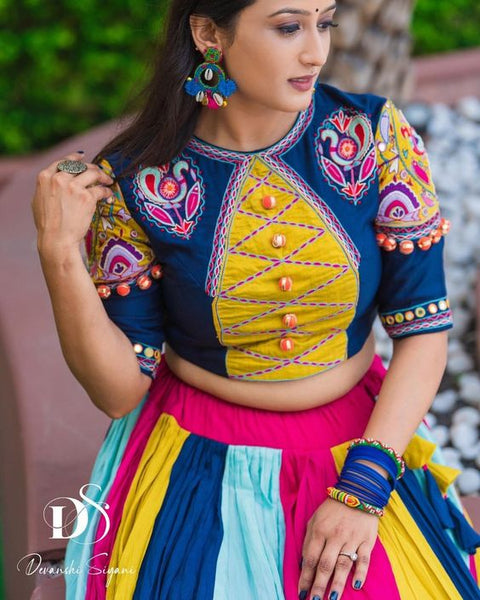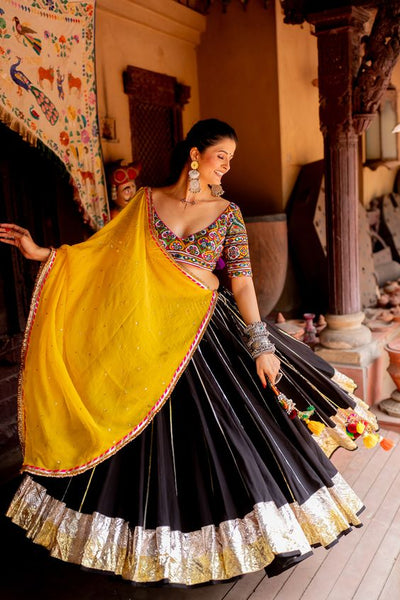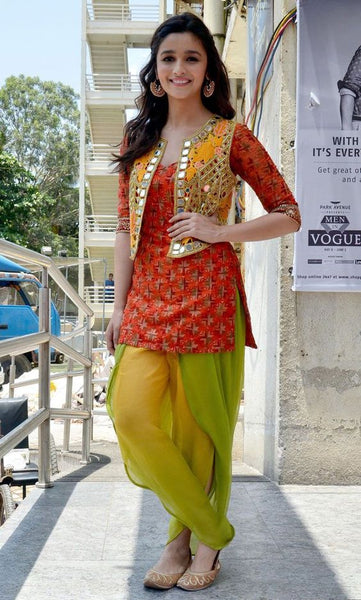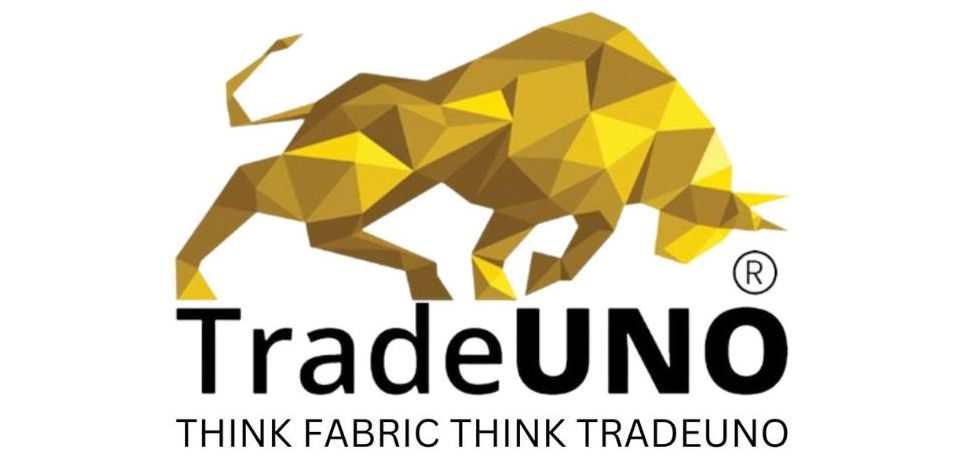Celebrate Navratri in style with versatile outfit ideas featuring a range of fabrics. Celebrate the vibrancy of the festival with cholis made of organza fabric for a comfortable and traditional look. Opt for elegant silk lehengas to add a touch of luxury to your Navratri attire. Experiment with lightweight georgette dupattas or vibrant crepe sarees to showcase your unique style during the festivities.
Enjoy the festive spirit with vibrant Navratri outfits crafted from elegant fabrics like silk, cotton, georgette, and chiffon. Experiment with traditional embroideries, intricate prints, and flowy silhouettes for a captivating Navratri ensemble.
Significance of Fabric in Navratri
Navratri celebrations are closely connected with the fabrics worn during the festivities. Traditional fabrics such as silk and cotton represent cultural richness and heritage, while lightweight options like chiffon and georgette reflect the spirited dances performed during the festival.
The choice of fabric plays a pivotal role, not only enhancing the aesthetic allure of Navratri attire for ladies but also signifying reverence for the divine.
Intricate embroideries and vibrant hues further amplify the festive spirit, transforming Navratri outfits into cherished ensembles that resonate with the essence of this auspicious occasion.
Each fabric selection contributes uniquely to the vibrant tapestry of Navratri fashion, adding depth and significance to the celebratory attire.

Traditional Fabrics Used in Navratri Attire
Navratri attire is filled with the essence of tradition, often showcasing fabrics deeply entrenched in cultural significance.
- Silk stands out as a luxurious and regal choice. It is highly desired for its opulent texture and often embellished with intricate zari work or delicate embroideries, elevating Navratri special dresses to majestic heights.
- Cotton emerges as a practical yet stylish option, providing breathability and comfort essential for the lively dance routines of the festivities.
- Additionally, khadi, a handwoven fabric, adds an authentic touch to Navratri dress ideas and is a testament to the nation's rich heritage and craftsmanship.
These traditional fabrics exude elegance and serve as powerful reminders of the age-old traditions celebrated with passion during Navratri.
Colours and Patterns Commonly Associated with Navratri
Navratri outfits are a vibrant celebration of colours and patterns, reflecting the joyous spirit of the festival.
|
Colour |
Pattern |
|
Red |
Bandhani |
|
Yellow |
Mirror work |
|
Green |
Embroidered motifs |
|
Blue |
Geometric patterns |
|
White |
Floral designs |
|
Orange |
Gota Patti |
|
Pink |
Peacock motifs |
|
Purple |
Chevron patterns |
|
Gold |
Paisley motifs |
These colours and patterns often embellish Navratri outfits, reflecting the celebration's festive spirit and cultural significance.
For a truly traditional look, opt for Bandhani or Leheriya patterns, which are created through intricate tie-dye techniques. These patterns not only add depth and texture but also pay homage to India's rich textile heritage. Incorporating mirror work, gotta-patti, or zari embroidery can further elevate the Navratri outfit ideas, creating a mesmerising display of craftsmanship.

While vibrant colours and intricate patterns are synonymous with Navratri celebrations, it's essential to strike a balance between tradition and personal style. Experiment with different colour combinations, mix and match patterns, and let your Navratri outfit reflect your unique personality and festive spirit.
Tips for Choosing Navratri Outfit Fabrics
When selecting fabrics for Navratri dresses for ladies, it's essential to consider the level of comfort, movement, and breathability required for the festivities. Lightweight fabrics like chiffon, georgette, and cotton blends are ideal for easy movement during energetic dances and Garba celebrations. While more luxurious, silk can be suitable for a more formal and elegant look. Get your Navratri outfits online this festive season and make heads turn.
Your Navratri special dress should have embellishments and embroidery work on the fabric because it adds a touch of traditional charm. Zari work, mirror work, and intricate thread embroideries are commonly seen on Navratri outfits, reflecting the festive spirit. Additionally, consider the drape and flow of the fabric, as they can contribute to the overall grace and elegance of your Navratri ensemble.
Factors to Consider When Selecting Fabrics for Navratri Outfits
When choosing fabrics for your Navratri outfit ideas, consider the following factors:
- Climate and weather: If the festival falls during warmer months, opt for breathable fabrics like cotton or lightweight silks.
- Level of activity: For garba and dandiya nights, choose fabrics that allow easy movement, such as chiffon or georgette.
- Occasion: For more formal events, heavier fabrics like silk or brocade can add a touch of elegance.
- Personal preference: Select fabrics that align with your style and comfort level.
- Budget: Fabrics like silk or embroidered pieces may be more expensive than simpler options. Buy a fabric based on your budget and preference.
Fabric Care and Maintenance During the Festival
Ensuring the longevity of your Navratri outfits involves proper care and maintenance throughout the festivities. Follow these tips to keep your outfit in good condition:
- Choose easy-to-clean and maintain fabrics, and adhere to recommended washing instructions to preserve their quality.
- Prevent exposure of delicate fabrics to excessive sweat or spills, as it can lead to staining or damage.
- Store your outfits carefully after each use to keep them in excellent condition for future celebrations.

Styling Suggestions for Different Types of Navratri Fabrics
The vibrant spirit of Navratri demands equally stunning attire! Here's how to style different Navratri fabrics for a look that's both festive and fabulous:
- Silken Elegance: Silk fabrics exude sophistication. Opt for intricate embroidery work, zari details, or delicate prints. Try lehenga cholis with stunning embellished tops or Anarkali suits with shimmering borders.
- Cotton's Vivacious Energy: Embrace the playful spirit of Navratri with vibrant colours and bold patterns on cotton fabrics. These are perfect for energetic garba nights! Pair a twirling ghani lehenga with a colourful printed choli or a flowy kurta with statement jewellery.
- Flowy Finesse with Chiffon and Georgette: Chiffon and georgette fabrics drape beautifully, allowing for graceful movement. Experiment with flowy silhouettes like Anarkali suits with dupattas that cascade around you or lehenga sets with soft gathers.
Accessorise Wisely:
When choosing Navratri clothes online with embellishments or embroidery, keep the rest of your accessories minimal. Wear delicate earrings and a statement bindi to complement the outfit's richness. Remember, balance is the key!
Conclusion
Choosing the suitable fabric for your Navratri outfit is crucial to ensure comfort, style, and a seamless celebration. By considering factors like climate, activity level, and personal preference, you can buy fabric from TradeUNO for a stunning navratri dress for ladies that reflects the festive spirit and allows you to dance and rejoice with ease.
Frequently Asked Questions:
1. What are some modern fabric trends in Navratri Outfits?
Ans: Some modern fabric trends for Navratri outfits include organza, satin, and velvet, which add a contemporary touch to traditional designs. Metallic fabrics like brocade and jacquard are also gaining popularity, offering a festive and glamorous look.
2. Where Can I Find High-Quality Fabrics for Navratri Outfits?
Ans: You can find high-quality fabrics for Navratri outfits in online stores like TradeUNO or by visiting local markets and exhibitions showcasing handloom and traditional fabrics. It's essential to inspect the fabric quality before making a purchase.
3. What are Some Fabric Layering Techniques for a Unique Navratri Look?
Ans: Fabric layering techniques for a unique Navratri look include:
- Combining sheer fabrics like chiffon or net over a solid base.
- Creating ruffles or cascading layers with lightweight fabrics.
- Experimenting with contrasting textures like silk and cotton to create depth and interest.
 Call Us
Call Us

